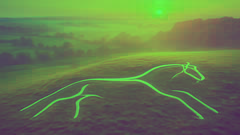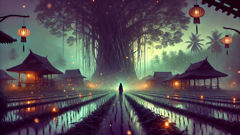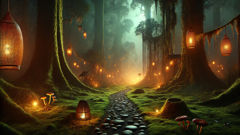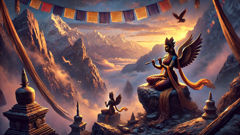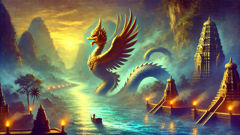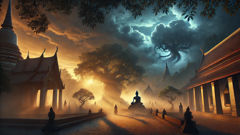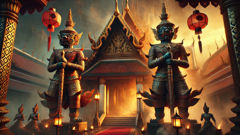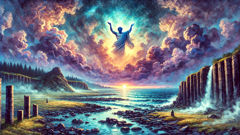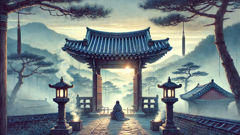Introduction
On the rolling green downs of Oxfordshire, where the land undulates like the sleeping back of some primeval beast, a single figure blazes white against the emerald slopes: the Uffington White Horse. Its lines are ancient and elegant, the chalky silhouette carved deep into the hillside, visible for miles under the ever-shifting English sky. For over three millennia, this enigmatic figure has watched as mist curled across the Vale, as seasons spun their endless dance, as generations lived and died in the shadow of the hill. Yet its story is older than iron or stone; it springs from the woven fabric of legend and belief, rooted in a time when the world itself seemed woven through with magic. Some say the White Horse is a symbol of kingship, a tribal emblem etched by people whose names have long since faded. Others claim it is a marker of conquest, the victorious stallion of a long-lost warlord. But among the oldest tales, whispered in hedgerows and flickering beside firelight, is the legend of Epona—the Celtic goddess who rode the wind, her spirit bound to the land, her sacred mare immortalized in chalk. This is the story of how the White Horse came to be: a tale of goddess and mortal, devotion and sacrifice, and the enduring bond between earth and sky. To walk these fields is to step into the breath of myth, to sense the pulse of ancient memory beneath each blade of grass. The very soil seems to hum with possibility, as if the White Horse itself might, at dusk or dawn, stir and gallop into the mist, leaving behind only the echo of hooves and the scent of wild thyme. The legend begins on a morning when the world was still young and the boundary between gods and mortals had not yet hardened—a time when humans could hear the thunder of divine horses and the goddess Epona wandered the green hills of Albion.
Epona’s Blessing: The Goddess of Horses and the First Dreamer
Long before Rome cast its shadow over Britain, before Saxon or Dane had trod the land, the people who called these hills home lived in tune with the wild rhythms of earth and sky. They built their settlements in hollows and on slopes, close to water and to sacred groves, guided by the seasons, by the stars, and by the spirits that danced in every breeze. Their world was one of connection—between human and animal, living and dead, seen and unseen. Among their gods, none was more beloved than Epona, the Horse Goddess. To her, the swift and noble animals of the downs were sacred; she was their protector, their mother, and their companion. In her presence, horses ran like wind and rivers, their manes streaming like banners of cloud. The people would offer her wildflowers, sweet oats, and the first foal of spring, hoping for her blessing in travel, in battle, and in the cycles of birth and death.
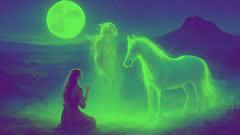
It was in this ancient time that a young woman named Arianwen lived in the village cradled in the Vale below the Dragon Hill. From childhood, she was marked as different—her hair pale as river pebbles, her eyes reflecting the stormy sky. She had a gift for understanding creatures, especially horses, whispering to them in soft lilting tones that made even the wildest mare bow her head in trust. Orphans and outcasts, beasts and people alike, found their way to her. The elders said she was touched by Epona, and when she walked alone at dusk, villagers would glimpse strange shadows beside her—hooves that left no print, eyes that shone like stars.
As Arianwen grew, so did the troubles of her people. Seasons turned harsher. The harvests shrank, and the ancient springs ran low. A sense of unease crept into the village; the land seemed restless, and even the horses grew skittish. When a blight struck the crops and a storm trampled the fields, the elders gathered under the moon, seeking answers. It was then that Arianwen, guided by a dream of white horses running through silver mist, stepped forward. She spoke of Epona’s sorrow, how the goddess longed for a sign that her people still remembered her, that they honored the sacred bond between human and horse, earth and sky.
The elders debated, fearful of angering unseen forces, but desperation makes bold hearts. That night, as stars wheeled above the downs, Arianwen climbed alone to the highest slope, where the grass grew short and the view swept far across the Vale. She knelt and prayed—not for herself, but for her kin and for the land itself. In answer, the moon broke free of cloud, bathing the hilltop in argent light. In that moment, the boundary between worlds grew thin, and Arianwen heard the thunder of hooves and the whisper of a mane in the wind. Epona appeared to her—not as a woman, but as a luminous white mare, her form woven from mist and moonlight, her eyes deep as the oldest earth.
“Child of my spirit,” Epona spoke in a voice that was both song and storm, “what would you give to heal your people, to bind their hearts to mine again?” Arianwen offered herself, her service, and her memory—whatever the goddess required. Epona nodded, touched her brow with a breath of warm wind, and vanished, leaving behind only the scent of wild thyme and the echo of distant whinnies.
When Arianwen returned at dawn, she bore a vision—a memory not her own. She gathered the villagers and told them what must be done. To honor Epona and ensure the land’s renewal, they would carve her likeness into the hill, making her spirit visible for all time. The people hesitated at first, daunted by the labor and the mystery, but Arianwen’s conviction was unshakable. United by hope and desperation, they agreed, not knowing how their work would shape the destiny of these hills for millennia to come.
The Carving of the Hill: Devotion, Sacrifice, and the Birth of the White Horse
At first light, the village gathered at the base of the high slope. Arianwen explained Epona’s vision: the goddess wished for her eternal companion—a great white horse—etched into the living chalk. Its form would ride across the hill for all to see, a beacon for travelers and a promise to future generations. There were murmurs of disbelief; no one had attempted such a feat. Yet hope had grown thin, and with Arianwen’s gentle leadership, they began.
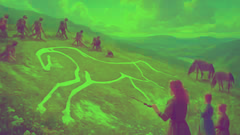
The work demanded more than muscle; it required unity and faith. Wise women traced the design in charcoal, guided by Arianwen’s dream-memory. The outline was strange yet beautiful—its lines long and fluid, more spirit than substance, as if shaped by the wind itself. Young and old alike set to digging, peeling away turf to expose the dazzling white chalk beneath. Their hands blistered, their backs ached, but as the days stretched into weeks, something remarkable happened. The people who had grown fearful and divided now laughed together over bread, sang as they worked, and told tales of Epona under starlit skies.
But as with all sacred acts, sacrifice was demanded. The labor taxed the weak and tested the resolve of the strong. Some villagers grumbled or doubted; others found new courage in Arianwen’s steady resolve. When tempers flared or hope flagged, she reminded them of Epona’s promise: that the land would heal if her likeness was honored. During one stormy night, lightning struck the ridge, splitting an ancient tree and frightening the horses in their paddock. Arianwen stood alone on the hilltop, arms raised, singing an old song her mother had taught her—one of peace and protection. The winds quieted, and in the morning, a rainbow arched over the chalk outline. The people took it as a sign.
Yet the greatest trial came not from weather or exhaustion, but from within. Old feuds simmered; some questioned whether they tempted fate by carving into sacred ground. When an elder’s son fell ill, blame threatened to unravel the fragile trust. Arianwen pleaded with them to hold faith, to remember why they had begun this work: not for glory or pride, but for survival and for love of land and horse. With every step forward, she poured her own strength into the project, until she seemed almost translucent—her hair luminous, her eyes burning with a strange inner light.
Finally, after a season of toil, the horse emerged. Its head was long and noble, its body stretched in full gallop as if leaping through time. The villagers gathered to celebrate. At dusk, as shadows lengthened and fireflies blinked among the wildflowers, Arianwen led a procession to the hilltop. Offerings of oats and garlands were laid at the horse’s head. The horses of the village—mares and foals—were led up to the chalk figure. They stood quietly, nostrils flared, as if recognizing an old friend. The air shimmered with possibility.
Then, beneath a sky awash with stars, Arianwen sang a hymn to Epona. As her voice rose and fell like the wind, a hush settled. Those present would later claim they saw a second horse—vast, luminous, ghostly—gallop alongside the chalk figure, its hooves never touching the earth. In that moment, the boundary between mortal and divine blurred. The land sighed in relief. Streams ran clear again, crops flourished, and peace returned to the Vale. The people had given shape to the goddess’s spirit, ensuring her blessing for generations yet unborn.
The Goddess’s Return: Legacy, Ritual, and the Living Chalk
As the years unfurled, the legend of the White Horse deepened its roots into the lives of the Vale’s people. Each spring, villagers would climb the hill to tend their creation, scraping away encroaching grass to keep the chalk brilliant. The ritual became known as ‘the scouring,’ an act both sacred and communal. Songs were sung to Epona; feasts were held in her honor. Horses were decorated with wreaths of wild thyme and bluebells and paraded along the ridge. Children chased each other across the hilltop while elders told stories of Arianwen and the night when two horses ran together under the stars.
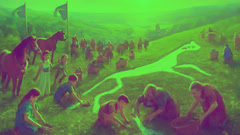
As generations passed, times changed. New tribes arrived, bringing their own gods and customs. Yet the White Horse endured. When invaders gazed upon it from afar, they marveled at its beauty and mystery. Some believed it a talisman of protection; others claimed it marked the resting place of a great hero or that it was a sign left by the gods themselves. But for those whose blood had always run with the chalk streams of Oxfordshire, it remained Epona’s gift—the bond between land and spirit made visible.
Arianwen herself passed into legend. Some said she vanished on Midsummer’s Eve, riding a white mare into a ring of mist that shimmered atop Dragon Hill. Others claimed she lived a long life as healer and wise woman, her descendants tending the chalk horse after her. In truth, her fate became as much a part of the landscape as the wild thyme and orchids that blossomed each spring. Her story was woven into every ritual: in songs sung at dusk, in offerings left at the horse’s head, in the laughter of children rolling down the grassy slope.
Over centuries, even as iron tools replaced flint and new tongues were spoken in the Vale, the scouring never ceased. In times of war and famine, when hope grew dim, villagers gathered together to restore the White Horse. They remembered Arianwen’s courage and Epona’s promise: that as long as the horse remained bright upon the hill, peace and plenty would return. The ritual became an anchor—a way to hold fast to identity, to honor ancestors, and to remind themselves that they were part of something larger than their own brief span.
Sometimes, on misty mornings or under the hush of falling snow, travelers claimed to see a white mare grazing near the hilltop, her mane glimmering in the dawn light. Children spoke in hushed voices of hoofbeats echoing through fog, or of waking to find garlands woven from fresh wildflowers at their windowsill—gifts from Epona or perhaps from Arianwen herself. And always, on the longest days and shortest nights, songs drifted up to where the chalk lines gleamed, a hymn of gratitude for land and life.
Thus, the legend of the White Horse of Uffington endured: not just as a symbol carved in chalk, but as a living story written in heart and memory. Its meaning shifted with the ages, but its spirit never faded. Even now, when the world has grown older and stranger, the White Horse runs on—its outline catching the sun at dawn and dusk, calling all who see it to remember that beneath our feet lies a world of wonder, woven from myth and hope.
Conclusion
The White Horse of Uffington is more than a figure etched in chalk; it is a testament to faith, creativity, and the enduring power of story. It stands as a bridge between worlds—past and present, mortal and divine. Those who visit its slopes today may come seeking history or beauty, but they leave with something deeper: a sense of connection to all who have walked these hills before. The tale of Epona and Arianwen lingers in the air, woven into every gust of wind and every shadow cast by dawn or dusk. Each scouring, each song sung in the Vale, renews the promise made on that ancient night—that as long as memory endures and hearts are willing to believe, the White Horse will continue to run across the hillside, its spirit forever bound to the land. In every age, it invites us to look beyond what is seen—to find wonder in earth and sky, and to honor the stories that make us who we are.

